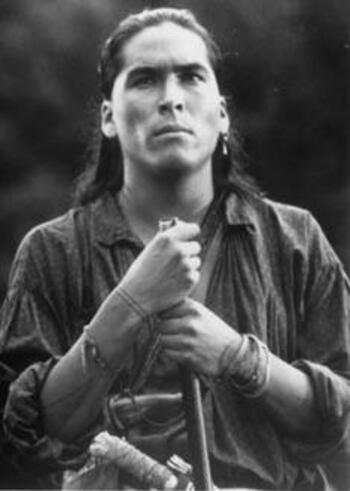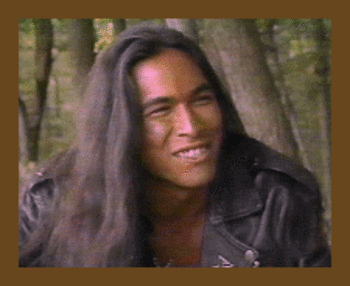-
Eric Schweig
Eric Schweig est un acteur de cinéma et un artisan canadien actuellement établi à Vancouver. Il est né le 19 juin 1967 à Inuvik, dans les Territoires du Nord-Ouest. D'ascendance Inuit par sa mère et Déné / Ojibwé par son père, il fut adopté à six mois par une famille germano-canadienne. Il passa son enfance à Inuvik jusqu’à l’âge de six ans, puis vécu en Floride et à Toronto.
À l’âge de 16 ans, Eric Schweig quitta sa famille adoptive et gagna sa vie comme travailleur de la construction. En 1987, alors qu’il avait tout juste 20 ans, il fut remarqué par un producteur de cinéma qui l’invita à auditionner pour un rôle dans La source du Chaman (The Shaman's Source, 1990). Sans aucune formation ni expérience d’acteur préalables, mais doué d’un réel talent naturel, Eric Schweig remporta l’audition. La source du Chaman lança ainsi sa carrière au cinéma.
Parmi toutes les productions télévisées et cinématographiques auxquelles il a participé depuis (plus d’une trentaine), on notera tout particulièrement son interprétation d’Uncas dans le film à grand déploiement Le dernier des Mohicans (Last of the Mohicans, 1992), de même que son interprétation de Pike Dexter dans Big Eden (2000), qui lui value le grand prix du jury au Festival du film gai et lesbienne de Los Angeles.
Parmi les nombreuses productions à caractère historique auxquelles il a participé suite au film Le dernier des Mohicans, Eric Schweig incarna le célèbre chef Mohawk Joseph Brandt / Thayendanega en 1993 dans La chaine brisée (The Broken Chain) où il tenait pour la première fois le rôle principal d’un film. Eric Schweig a également joué quelques premiers rôles marquants dans des films plus contemporains témoignants des problèmes sociaux vécues par les premières nations d’Amérique du Nord : Skins (2002), Cowboys and Indians: The J.J. Harper Story (2003) et One Dead Indian (2006).
En parallèle à sa carrière d’acteur au cinéma, Eric Schweig entama dans les années 90 une démarche artistique lui permettant de renouer avec ses racines autochtones. Comme de nombreux inuits du Canada, Eric Schweig pratiquait depuis l’enfance la scuplture de petits objets sur bois ou sur pierre (personnages, kayak, etc.). Grâce au mentorat de l’artiste Vern Etzerza, il étudia la sculpture traditionnelle des Amérindiens de la côte du Pacifique puis resserra sa pratique sur la réinterprétation des masques spirituels inuits, en collaboration avec le maître sculpteur Art Thompson.
La série de masques créée par Eric Schweig s’avère non seulement une tentative réussie de renouer avec ses origines et l'art inuit mais aussi une nécessaire œuvre de résilience face aux traumatismes de son enfance. En 1999, au Vancouver Inner City Foster Care Conference, Eric Schweig livra en effet un vibrant témoignage de sa douloureuse expérience d’adoption et de violence familiale. Conséquence funeste de ce déracinement et de cette maltraitance, Eric Schweig lutta pendant de nombreuses années contre sa dépendance à l'alcool et à la drogue.
Sa célébrité d’acteur lui permis de témoigner de son expérience de vie lors de nombreuses conférences au Canada et aux États-Unis et d’ainsi sensibiliser le grand public à la cause autochtone pour la protection de l’enfance."Adoption of aboriginal children by Caucasian couples is to me, for lack of a better term 'State Sanctioned Kidnapping.' Too often Euro-American couples are preoccupied with the romantic notion of having a "real live Indian baby" or a "real live Inuit baby" which instantly transforms the child into an object rather than a person. For decades our communities' babies have been unceremoniously wrenched from the hands of their biological parents and subjected to a plethora of abuses. Physical abuse, mental abuse, sexual abuse and a host of others.
I have first-hand knowledge of this because I was one of those children. For years my adoptive parents beat me bloody on a regular basis. I've been trapped in rooms naked and beaten with belt buckles, hockey sticks, extension cords, and once with a horsewhip.
I'm not saying this to shock you or to gain pity; I'm just stating fact. I eventually grew tired of living in a prison without walls and ran away when I was 16. What transpired between then and now has been a roller coaster of alcohol, drugs, violence, failed relationships, despair and confusion. Who am I? Where do I come from? Where is my family? Where do I belong? When life's mystery has been shattered by strangers watching over you, a lot of these questions are lost.
There has been some good times as well, regardless, but for reasons that I've just started to understand, there has always been an impending sense of doom that controlled my actions and behavior, but now that I've been clean and sober for 8 months and actually started working on myself I'm beginning to step out of my father's shadow and into the light of day where life isn't so murky or such a struggle."
"Florence Raddi never realized she had a cousin who was a rising movie star. But last week, when she met Eric Schweig from the "Last of the Mohicans", there was no question in her mind. He was her cousin. “ He looks like my uncle”, she said shortly after coming face to face with Schweig in the Brass Rail Lounge. Raddi was just one of several relatives who Schweig met for the first time. He left Inuvik at the age of six with his adoptive parents almost 20 years ago. Schweig was the natural son of former Inuvik and Yellowknife resident Margaret Thrasher.
The name given to him at birth was Ray Thrasher. But at 6 months, he was adopted by a German father and French mother. His father was in the Navy and they moved from Inuvik to Bermuda. Schweig said his adoptive grandmother told him who his birth mother was. Than one day in Vancouver,where he now lives, he met Willie Thrasher on the street.The two got talking and before long Schweig realized he must be related to Thrasher. He said Thrasher hooked him up with his Aunt Agnes in Williams Lake, B.C. in the hopes of finding his mother. But three days later,his birth mother died and he was too late.
Schweig said he had a strange feeling that he might never meet his mother after a dream he had when he was 18. In the dream he was walking towards a house where he could see a woman that he knew was his mother but when he was 5 feet from the open door it slammed shut. “I was crying when I woke up..it was so vivid”, Schweig said. He doesn’t know much about his mother but he has been told of her fondness for alcohol and that she looked after the homeless people in Yellowknife. “I would have liked to have met her’, Schweig said. He said the stories he has heard about her haven’t disappointed him.
Schweig hasn’t found any of his brothers or sisters yet but he thinks if he keeps telling his story one of them are sure to hear it and get in touch with him. And while he will never meet his mother, last week’s return trip to Inuvik for Peter Gzowksi's Golf Tournament gave Schweig a chance to meet relatives and re-live some memories. After almost two decades,the trip back sparked some memories for Schweig, now 25. The memories are mostly of buildings such as the Igloo Church and Large Family Hall. “It’s strange, it’s like being in a new place”, said Schweig.”But some things are familiar.” One memory the return visit sparked was his first, and only day, at Sir Alexander Mackenzie school. “I was only there about two minutes and jumped on my desk and broke it”, laughed Schweig.”The teacher saw it and sent me home.
” Last week’s trip also roused a desire to spend time in the region meeting his relatives, learning about the Inuvialuit and spending time on the land. Schweig admitted his knowledge about the Inuvialuit is limited to what he has read in books.That is why he wants to come back soon so he can find out” what I am and where I come from”. “It’s like reading about a roller coaster”, he explained. “it’s a lot more fun to ride it (than read about it.)” Schweig, an Inuvialuit beneficiary, said he is getting the information on enrolling under the claim but doesn’t want any financial benefits. He’d rather that go to someone who needs it.” I try to be self-sufficient.
” Schweig spent much of his childhood north of Toronto.When he was 16 years old Schweig left home and headed for Toronto. That is where he got his first start as an actor. He was walking down the street and a guy told him a producer was looking for Indians to act in a low-budget film. Schweig, figuring he could act, went in and then landed the lead in the picture. After that movie he got a video tape of his best scenes, found himself an agent and eventually wound up in the Last of the Mohicans. His role as Uncas,the lead’s brother, in that movie was his big break.But Schweig said acting isn’t his life. “ I’m not a career-oriented person”, explained Schweig.” I just do it for fun like my roller-bladeing.
” He was heading for Los Angeles,after spending the night in Edmonton Friday,where he was scheduled to do a voice-over for an animated feature. Schweig said he has several different options right now and expects to be busy in late spring."
-
Commentaires
2punaatuaiMardi 5 Juin 2012 à 02:52Bonjour à toi, Eric, du bout du monde. je t'écris de Tahiti, en Polynésie française, et je suis heureuse de pouvoir le faire. Si la langue française te gene, je peux aussi communiquer en anglais. A bientot, si tu veux. Ia ora na ia oe!
3CtriplebJeudi 9 Août 2012 à 21:39I speak English only but I just want to say I am SO sorry for the abuse you have gone through. I am white and live in the USA but I do agree with you. You were ripped from your people and for that I am very very sorry. I've been doing research about what your people have been through (especially the children) with the "reform schools". In am currently doing a graphic arts project about these children and what they suffered.

Mitakuye Oyasin - Nous sommes tous reliés
Par les 3 rayons d'or du soleil invaincus, je te salue !
/|\
 Suivre le flux RSS des commentaires
Suivre le flux RSS des commentaires
 Ajouter un commentaire
Ajouter un commentaire





J'esp? que tu vas bien. Voil?e voulais te donner le lien d'Eric sur myspace son site perso, cela peut t'interesser je pense. Tu peux lui laisser des messages, mail ect ?oi de voir.
www.myspace.com/ericschweig
Amicalement Tallulah